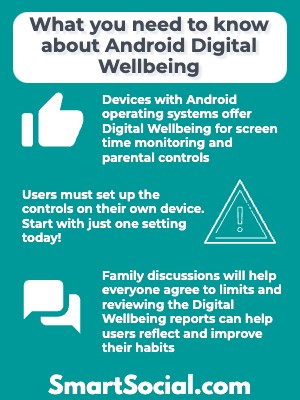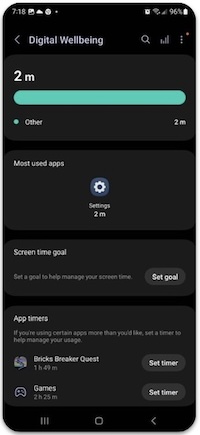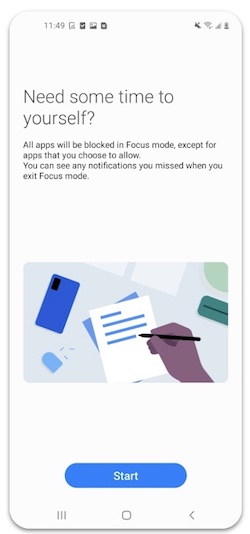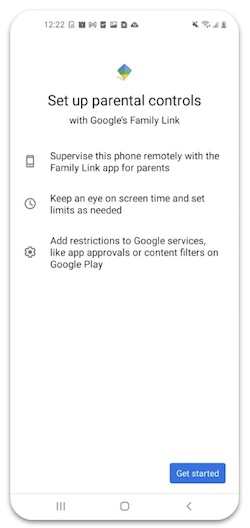Digital Wellbeing and Parental Controls for Android: Complete Guide for Parents

., start learning from this page to earn points towards a Starbucks gift card!*
Hi, I'm Josh, the founder of SmartSocial.com.
Keep reading, and soon you'll get a chance to share your thoughts and earn points for a reward!
Digital Wellbeing and Parental Controls for Android: Complete Guide for Parents

., ¡comienza a aprender en esta página para ganar puntos para una tarjeta de regalo de Starbucks! *
Hola, soy Josh, el fundador de SmartSocial.com.
No abandone esta página hasta que complete nuestro formulario de comentarios que aparecerá cuando aprenda de los recursos...

Android devices are popular choices for many students and families. Devices that operate on the Android system have built-in systems called “Digital Wellbeing” and “Parental Controls” to help parents monitor what is being done on the device and guide students toward positive digital habitsThis guide will help parents learn what Digital Wellbeing is, how to configure it to keep their students safe on their devices and explain Parental Controls and Family Link.
What is Android’s “Digital Wellbeing”?

- Devices that operate on Android operating systems have built-in screen time monitoring and additional controls through the Google Family Link app
- Digital Wellbeing allows users to set real-time or scheduled screen time rules to help create and enforce good habits while kids are on their devices
- ~Digital Wellbeing is controlled on each individual device
- Google Family Link allows parents to set restrictions on screen time and what apps kids can use on their device
- ~Google Family Link can be controlled and monitored from a parent’s own device (including Apple devices)
Download our Android Parental Controls Quickstart Guide
Does setting up parental controls on your Android phone or device feel overwhelming.
Download our Android Parental Controls Quickstart Guide here and we'll walk you through the process.
Parent and student tips & walk through (video)
What are Parental controls (via Google Family Link)?

- Google Family Link allows parents to set digital “ground rules to help guide [students] as they learn, play, and explore online.” (Source: Google)
- Parents can view their student’s activity, manage the apps on their Android/Chrome OS devices, and get recommendations of apps for their students
- Through the Google Family Link on the parent’s own device (including Apple products and web browsers), parents can set device limits for each member in their Google family and even lock the device when it’s time to do something different
- Students must have their own Google Account and this account must be the only user on the device the parents want to manage with Family Link
- ~Students under 13 can sign up for an account that is managed by a parent with Family Link (“How to Create a Google Account for Your Child”)
- ~Students 13 and over have the ability to “stop supervision” on their device according to Google, but parents will be notified and the device will be temporarily locked and unusable if they make this selection
Android & Apple parental control similarities
- Both devices allow users to set screen time limits. For Android, this is called “Digital Wellbeing”; the name on Apple is “Screen Time”
- iOS and Android both have GPS installed, making devices trackable at any time
- Android and Apple phones can both be monitored on a separate device
- ~On Android devices, parents can download the Google Family Link app from any device (Apple or Android) to set restrictions on screen time and approve or decline what apps kids use on their devices
- ~For Apple devices, parents will need to create an Apple ID for their child that can only be managed from another Apple device
- Parents can configure settings in either the Google Play Store or the Apple App Store so that a password must be entered before their student downloads a new app
- ~Students can potentially get around the parental control of entering a password to download an app by using a third-party store. There are more third-party app stores available on Android devices than Apple devices
Unique differences between Android & Apple parental controls
- On Android devices, parents can lock the phone at any time through the Family Link app
- Android devices are integrated well with platforms your student most likely uses at school, such as Gmail, Google, Google Chrome, etc.
- On Apple devices, parents can limit their children to text only or to communications with only their contacts. Parents can add or delete current contacts and approve or decline new contacts
- Parents can completely remove the App Store on Apple devices
- It is possible to disable passcode changes on iOS products
- If an app has been approved for download and a parent later deletes that app, Apple allows the student to download the app again without parental approval, while Android devices will send an approval request to the parent before the app can be downloaded again
Why should parents & educators care?
- Because Android allows users to download apps from various third parties, there is a larger app library, making it more likely for parents to be unfamiliar with apps their children are using
- If your student has customized their phone, it may be harder initially for you to navigate the unique setup
What can parents & educators do?
.jpeg)
- Talk as a family about what guidelines, rules, and parental controls are appropriate for your kids. Make sure to include your kids in the conversation to help set and understand the limitations from the start
- Use the SmartSocial Family Media Dialogue & Agreement Guide WITH your students to create a written agreement for your family
- When a new device is introduced into the family, take your time getting to know it yourself before giving it to your kids
- ~Once kids have access to the device, work together to discover and see how students use the device and what they find
- Ask yourself if the limits you set for your kids’ devices are reasonable and enforceable as a family
- Remember, some kids can figure out ways to get around all parental controls or monitoring apps, so having open conversations and physically seeing how your student uses their device for yourself is the safest way to monitor and protect your kids
- Take the time to regularly monitor the devices and screen time with the automated screen time reports in Digital Wellbeing
Privacy/setting recommendations for Android
How to find and use Digital Wellbeing?

- Tap "Settings" on your device
- Scroll down the menu and tap “Digital Wellbeing and Parental Controls”
How to set screen-time goals in Digital Wellbeing
- Tap “Screen time goal” in the Digital Wellbeing menu
- Tap the “Set goal” button on the middle right of the screen to create a new daily goal
- (Note: If you already have a time set, tap the button that says “Goal”)
How to set timers for specific apps with Digital Wellbeing
- Tap “App timers” in the Digital Wellbeing menu
- Search for an app by name, or scroll through the list of installed apps and tap on the app you want to set a daily limit for (example: tap on YouTube Music)
- Tap the app(s) you would like to “set the timer” for and apply parameters
- ~(Note: Timers reset every day at midnight)
What is “Focus mode”? How to set “Work time” and “Me time”

- ~Scroll down in the Digital Wellbeing menu; under “Looking for something else” tap “Focus mode”
- ~Select which mode or routine you would like to set parameters for, i.e. Sleep, Theater, Driving, Exercise, Relax, Work, or Custom
- Focus mode allows users to set what apps can be used during a specific time with “Work time” and “Me time”
- Users can add different apps in these settings for different purposes or create an additional category
- ~Example: A user may choose to select work apps such as a calculator or calendar, but not social media or photos while in “Work time,” or they may select “Only Messages and Phone,” blocking all other apps during “Me time”
- The Clock, Google Play Store, Phone, and Messages are always allowed in Focus mode
What is “Bedtime mode” and how to set your bedtime?
During the set bedtime, the device’s screen will change to grayscale. Calls, alerts, and other sounds are muted. To set Bedtime:
- Scroll down in the Digital Wellbeing menu and tap “Bedtime mode”
- If setting up for the first time, select “start” and enter the desired parameters for bedtime mode
- Tap “Turn on” or “Turn off” to manually start or stop bedtime settings
- Alternatively, tap “Turn on automatically” and set a schedule and what days the schedule should be automatically turned on
What is “Driving monitor?”

“Driving monitor” detects when the device is connected to a car via Bluetooth and shows a report of how the user has accessed the phone while driving
- Tap “Screen time while driving” from the Digital Wellbeing menu
- Allow connection to Bluetooth if prompted
- If using “Driving monitor” for the first time, tap “Start” and select the apps that should not be included in the screen time data while driving (navigation apps, for example) and then tap the blue “Start” button
- To choose excluded apps after you have already started Driving monitor, tap the 3 dots on the top right and tap “Choose excluded apps”
What are Parental controls (via Google Family Link)?
- Google Family Link allows parents to set digital “ground rules to help guide [students] as they learn, play, and explore online.” (Source: Google)
- Parents can view their student’s activity, manage the apps on their Android/Chrome OS devices, and get recommendations of apps for their students
- Through the Google Family Link on the parent’s device (including Apple products and web browsers), parents can set device limits for each member of their Google family and even lock the device when it’s time to do something different
- Students must have their own Google Account and this account must be the only user on the device the parents want to manage with Family Link
- ~Students under 13 can sign up for an account that is managed by a parent with Family Link (See “How to Create a Google Account for Your Child” from Google For Families Help)
- ~Students 13 and over have the ability to “stop supervision” on their device according to Google, but parents will be notified and the device will be temporarily locked and unusable if they make this selection
How to access Parental controls on your student’s Android device

- Download the Family Link app on the parent’s device (read our Google Family Link Guide to find out more information). Log in to the device you want to manage using the student’s Google account
- On your student’s device, tap “Parental controls” in the Digital Wellbeing menu
- If using Parental controls for the first time on this device:
- ~Tap “Get started”
- ~Select “Child or teen” for who will be using the device
- ~Select your student’s account to be managed
- Read the supervision information with your student and enter the student’s password at the bottom of the information
- Tap “Allow” and follow the prompts from Family Link to set up key features like:
- ~Screen time limit
- ~Allow or block apps
- ~Find your child’s location
More screen time and parental control resources for parents, students, & educators
.jpeg)
- To learn more about different parental control software options for your family visit our Parental Control Software Comparison Guide
- Learn more about parental controls for Apple and Android devices in Smart Social's Device Safety Tips and Parental Controls ebook
- How to Keep Students Safe on Google Hangouts
- Google Play Parental Controls: How to Block Mature Apps & Media
- Google Family Link Guide for Parents & Educators
Conclusion
Tracking the amount of time your family spends on their devices, and in what ways, is a great way to start regulating screen time and building positive habits. If anyone in your family has an Android device, consider configuring Digital Wellbeing and Google Family Link, but understand that there are still ways for students to bypass those restrictions.
Become a member or log in to learn more on this topic
Únase a nuestros próximos eventos de preguntas y respuestas para padres en vivo (y gane una tarjeta de regalo de Starbucks de $5) *
Here are some of the latest resources at SmartSocial.com
Become a Very Informed Parent (VIP) to get our social media suggestions in your email every Tuesday & Thursday.



Hola, soy Josh, el fundador de SmartSocial.com. Proteja a su familia respondiendo mi cuestionario de 1 minuto
Este cuestionario lo ayudará a comprender qué tan segura está su familia.


Escuelas y distritos: Asóciese con nosotros para proteger a su comunidad en línea
Nuestras presentaciones remotas (y nuestro sitio web) enseñan a más de un millón de estudiantes cada año cómo brillar en línea. Enseñamos a los estudiantes cómo se pueden usar sus cuentas para crear una cartera de logros positivos que impresionen a las universidades y a los empleadores.


Únete a nuestro Inteligente Podcast social
cada semana en iTunes
Con más de 240 episodios, Josh Ochs entrevista a psicólogos, terapeutas, consejeros, maestros y padres mientras te muestra cómo navegar por las redes sociales para algún día brillar en Internet.
Escucha en:




%20(1).jpg)

.jpg)


.jpg)

.jpeg)
